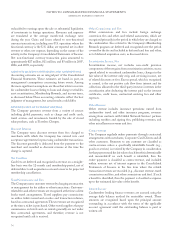American Express 2007 Annual Report Download - page 78
Download and view the complete annual report
Please find page 78 of the 2007 American Express annual report below. You can navigate through the pages in the report by either clicking on the pages listed below, or by using the keyword search tool below to find specific information within the annual report.NOTES TO CONSOLIDATED FINANCIAL STATEMENTS
AMERICAN EXPRESS COMPANY
specific identification method on a trade date basis. In addition,
realized losses are recognized when management determines
that a decline in value is other-than-temporary, which requires
judgment regarding the amount and timing of recovery.
Indicators of other-than-temporary impairment for debt
securities include issuer downgrade, default, or bankruptcy.
The Company also considers the extent to which cost exceeds
fair value, the duration and size of that gap, management’s
judgment about the issuer’s current and prospective financial
condition, as well as its intent and ability to hold the security
until recovery of the unrealized losses.
Trading investment securities are carried at fair value on
the Consolidated Balance Sheets, and changes in fair value are
recorded in results of operations.
The Company obtains fair value of investment securities
primarily from third party pricing vendors engaged by the
Company. When available, quoted market prices are used to
determine fair value. If quoted market prices are not available,
fair values are estimated using pricing models, where the inputs
to those models are based on observable market inputs. The
inputs to the valuation models vary by the type of security
being priced but are typically benchmark yields, reported
trades, broker dealer quotes, and prices of similar assets. Pricing
models generally do not entail material subjectivity because
the methodologies employed use inputs observed from active
markets. In limited cases observable market prices and input
may not be readily available or availability may be limited due
to market conditions. Internal models may be used in these
situations to determine fair value. This represents less than 0.1
percent of the Company’s total assets.
Loans
Cardmember lending
Cardmember loans represent amounts due from lending product
customers. These loans are recorded at the time a cardmember
enters into a point-of-sale transaction with a merchant or
when a charge card customer enters into an extended payment
arrangement. Cardmember loans are presented on the
Consolidated Balance Sheets net of reserves for cardmember
losses, discussed below, and include accrued interest receivable
and fees as of the balance sheet date. The Company’s policy
is to cease accruing for interest receivable once a cardmember
loan is more than 180 days past due.
Reserve for losses — cardmember lending
The Company’s methodology for reserving for losses relating
to cardmember loans is consistent with reserving for losses
relating to cardmember receivables, with the exception that
cardmember loans (other than those in bankruptcy or owed by
deceased individuals) are written off when 180 days past due.
Asset Securitizations
The Company periodically securitizes cardmember receivables
and loans by transferring those financial assets to a trust. The
trust then issues securities to third-party investors, and these
securities are collateralized by the transferred assets. The
Company accounts for its transfers of these financial assets in
accordance with SFAS No. 140.
In order for a securitization of financial assets to be
accounted for as a sale, the transferor must surrender control over
those financial assets to the extent that the transferor receives
consideration other than beneficial interests in the transferred
assets.
Cardmember loans are transferred to a QSPE, and such
transactions are structured to meet the sales criteria. Accordingly,
when loans are sold through securitizations, the Company
removes the loans from its Consolidated Balance Sheets and
recognizes both a gain on sale and retained interests in the
securitizations.
In contrast, cardmember receivables are transferred to a
special purpose entity, a trust that does not meet the requirements
for treatment as a qualifying sale. Securitizations of cardmember
receivables are accounted for as secured borrowings.
Land, Buildings and Equipment
Land, buildings and equipment
Buildings and equipment, including leasehold improvements,
are carried at cost less accumulated depreciation. Costs incurred
during construction are capitalized and are depreciated once an
asset is placed in service. Depreciation is generally computed
using the straight-line method over the estimated useful lives
of assets, which range from three to eight years for equipment.
Buildings are depreciated based upon their estimated useful life
at the acquisition date, which generally ranges from 40 to 60
years.
Leasehold improvements are depreciated using the straight-
line method over the lesser of the remaining term of the leased
facility or the economic life of the improvement, which ranges
from five to ten years. The Company maintains operating leases
worldwide for facilities and equipment. Rent expense for facility
leases is recognized ratably over the lease term, and is calculated
to include adjustments for rent concessions, all non-market
based rent escalations, and leasehold improvement allowances.
Software development costs
The Company capitalizes certain costs associated with the
acquisition or development of internal-use software. Once the
software is ready for its intended use, these costs are amortized
on a straight-line basis over the software’s estimated useful life,
generally five years.
76
























